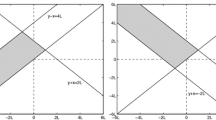Abstract
We describe a lineal of initial data of a simple conservative scattering system that can be transferred to zero by a sequence from l 2. The proof is based on the known relationship between the Lax-Phillips scattering theory and the theory of unitary operator nodes developed by Szokefalvi-Nagy, Foias, and Brodskii.
Similar content being viewed by others
REFERENCES
D. Z. Arov, “Passive linear stationary dynamical systems,” Sib. Mat. Zh., No. 20, 211–228 (1979).
M. S. Brodskii, “Unitary nodes and their characteristic functions,” Usp. Mat. Nauk, 33, No.4, 141–168 (1978).
M. A. Nudel'man, “Sufficient conditions for the absolute stability of optimal passive scattering systems,” Alg. Analiz, 6, No.4, 187–203 (1994).
V. M. Adamyan and D. Z. Arov, “On unitary couplings of semiunitary operators,” Mat. Issled., No. 1, 3–66 (1966).
B. Szokefalvi-Nagy and C. Fois, Analyse Harmonique des Operateurs de l'Espace de Hilbert, Bucharest (1967).
Author information
Authors and Affiliations
Additional information
__________
Translated from Ukrains'kyi Matematychnyi Zhurnal, Vol. 57, No. 4, pp. 559–563, April, 2005.
Rights and permissions
About this article
Cite this article
Nudel'man, M.A. On Initial Data of a Simple Conservative Scattering System That Can Be Transferred to Zero by a Sequence of Inputs from l 2 . Ukr Math J 57, 671–677 (2005). https://doi.org/10.1007/s11253-005-0218-3
Received:
Issue Date:
DOI: https://doi.org/10.1007/s11253-005-0218-3



